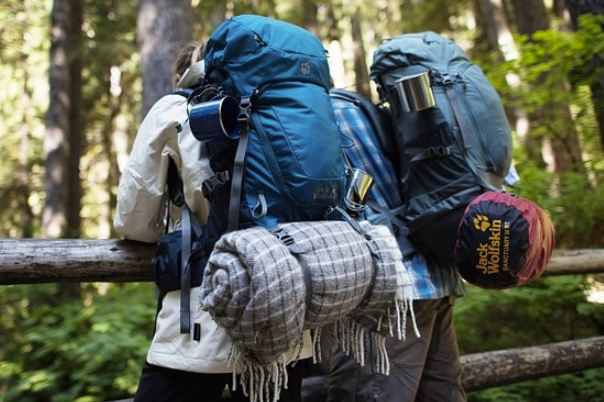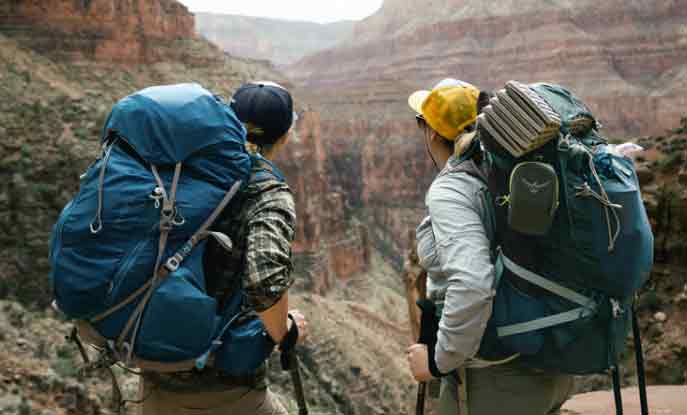1. Bracket
Medium and large mountaineering bags usually form a carrying system with a back frame as the center, and the back frame can be divided into two types: outer frame and inner frame.
(1) The outer frame backpack is to fix the best travel backpack on a hard frame (aluminum alloy is the most common), with a tightened nylon shoulder strap and hip fixing belt. The center of gravity of the outer frame is high, about at or above the shoulder. The high center of gravity design is not suitable for occasions that require a high degree of balance, and is suitable for flat roads.
The outer rack type is easy to load and use, and the weight can be shared by the shoulders and hips. Good ventilation on the back. The disadvantage is the practical inconvenience of the frame in different situations. For example, when walking in dense forests or bamboo bushes, the backpack is easy to be hooked or jammed, and it is easy to suddenly shift the center of gravity and lose balance when climbing or skiing. Therefore, the outer frame backpack is more suitable for long-distance walking on flat roads.

(2) The inner frame type is usually wrapped by nylon fabric inside the bag. The center of gravity of the inner frame is slightly lower and can be adjusted approximately between the shoulders and hips. It is suitable for climbing occasions that need to maintain balance, and can prevent the backpack from shaking at shoulder height. The advantages of the internal frame type are comfort and stable center of gravity. The weight distribution is reasonable and the movement is free. The disadvantage is that the storage space is relatively long and narrow, so pay attention to the reasonable allocation of space when packing. There is also poor ventilation, and the back is close to the body.
2. Belt
The waist belt is a component that transfers the weight of the large travel backpack from the shoulders to the hips. It is the most critical part of the entire carrying system. Generally, the heavier the weight, the wider and thicker the belt should be selected. The waistband usually has several parts such as padding, the inner and outer sides of the waistband, buckles, straps, waist pads and reinforced load-bearing structure. Among them, the most important indicator to measure its pros and cons is the padding. High-quality belts are usually lined with soft and thick foam to better fit the buttocks and allow the wearer to keep the upper body straight, even if they are walking for several hours. Will not feel exhausted.
3. Inside and outside of the belt
Simply put, it is the part that wraps the cushion and the layer where the belt is exposed. Due to the inherent abrasion resistance of nylon, most backpacks use this fabric to make the inside and outside.
4. Buckle
Most of the three-pronged buckles have the advantage of being strong and easy to use, but the disadvantage is that they are easy to be trampled or crushed. Therefore, for long-term outdoor activities, you can consider bringing spare buckles.
5. waist belt stabilization belt
It allows the backpack to fit the hips more closely and increase stability. Most of the inner support type backpacks have this structure, and some also have diagonal straps to further transfer the load to the waist.
6. Waist pad
It is an extra structure added to support the back waist, and most inner-frame backpacks use this design. If the lumbar pad is too hard or too soft, it is easy to cause waist pain when the weight is heavy.
7. Strengthen the load-bearing structure
The belt of a backpack with a large load usually needs to adopt a reinforced load-bearing structure to avoid distortion when subjected to force. Most backpacks are supported by thermoplastic foam to tightly wrap around the body and not easily deform. According to the combination with other parts, there are two types of waistbands: structural continuous type and stitched type. The former usually passes between the waist pad and the main body of the backpack, and is connected to the waist pad by a buckle. It has excellent stability. Most top backpacks use this design. The latter is sewn to the backpack.

8. Shoulder strap
Prevent the backpack from leaving the body and falling backwards, while also taking into account the weight. Most of the shoulder strap padding materials are foam, and the style is inwardly curved. The key to determining whether the shoulder strap is comfortable is the width between the two shoulder straps. Some backpacks can adjust the width of the shoulder strap, or change the size of the shoulder strap according to the body shape.
9. Load-bearing belt
Also known as the shoulder strap tightening strap, it is a design that connects the body of the bag to the top of the shoulder strap. Its function is to draw the backpack closer to the body, so that the user will not feel that the carry on backpack is falling backwards, and at the same time, it can also transfer the weight of the shoulder muscles to the collarbone. Most load-bearing straps are sewn on the shoulder straps, and the best effect is that the load-bearing straps form an inclination angle of about 45° with the top of the shoulder straps.
10. Chest strap
It is connected to the shoulder strap by fasteners or sutures to prevent the shoulder strap from sliding down to both sides and maintain stability. Most chest straps are of flat belt structure, and some parts are joined with elastic materials to prevent excessive shrinkage during adjustment. The best position of the chest strap is that the upper edge is almost flush with the neck to minimize the pressure on the chest.

11. Backpack Gasket and Back Gasket
Located on the back side of the waist belt to prevent irregular objects from squeezing the back. Usually most of the inner support system will use a large area of thermoplastic foam as a cushion, and then wrap the cushion with a mesh fabric to help accelerate the evaporation of sweat or moisture. The outer bracket type backpack uses a horizontally tight back cloth to avoid discomfort caused by the bracket crossbar close to the back. The material of the back cloth is generally a mesh cloth with good air permeability.


